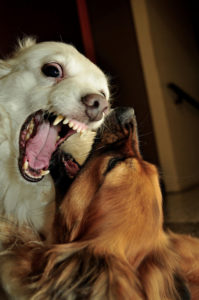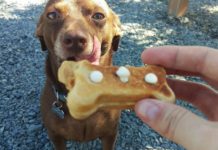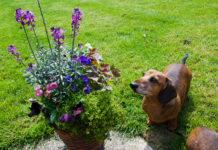Aggressive Encounters – Review of Part 1
In Part 1 of our series on aggressive dogs, we discussed several different safety protocols to follow in order to help keep yourself and your loved ones safe from possible aggressive or fear-related attacks by dogs you may not know very well, or not know at all. The main points to remember during an encounter with a stressed or potentially dangerous dog, are to remain as calm as possible, and try to diffuse the situation to the best of your ability.
“Do not run away from the dog!”
This will most likely invoke a chase response from aggressive dogs, and one in which you are likely to lose.
By learning and following the points discussed in Part 1, you’ll be better equipped to prevent potential attacks, and limit the amount of damaged sustained, should an attack occur.
Approaching Known Aggressive Dogs
In this section, we will discuss the topic of properly greeting and handling known dogs that have had a history of aggressive tendencies. Treatment plans for modifying aggressive behavior will not be discussed in this article.
The main talking points will revolve around safety information to better handle or prevent aggressive encounters, either to yourself or to friends and/or family members by dogs you are very familiar with. For articles regarding treatment plans for the m odification of behavior problems concerning various types of aggression, please search our website for more information.
odification of behavior problems concerning various types of aggression, please search our website for more information.
The first thing owners of aggressive, or potentially aggressive dogs must do is set the dog up for success at all times. What this means is that owners of these types of dogs must refrain from any activities that are known to provoke an aggression response in the dog.
If the dog is reactive towards house guests, then the dog must be removed and prohibited from any areas guests may enter during their visits. Rooms or locations where the dog is being held must locked to prevent accidental escapes.
If you read our article on Canine Behavior Problem Solving, you learned about environmental triggers and their effect on behavior problems. Do your best to eliminate or reduce potential aggression-invoking triggers and properly manage the dog’s environment to help him avoid all dangerous situations.
If you are unable to remove the possible problem triggers from the dog’s environment, then the dog must be removed from the environment for the time being, until all potential triggers are no longer present.
Ensure that you are doing your best not to reward/encourage inappropriate or aggressive behavior. In other words, don’t fuel the fire with aggressive dogs. If you know that your dog becomes aggressive with certain types of toys, or when he is allowed to engage in certain activities, then those toys must be removed from the dog.
Also, all activities that encourage or foster aggressive behavior must be abruptly stopped until the dog has learned to release any and all “problem” toys or learned to stop all problematic activities upon owner request.
If the dog reacts unfavorably to being removed from a certain chair or section of the house, actions must be taken to prohibit the dog from gaining access to these “very valuable resources” until the dog has learned to move from them when requested.
Using Common Sense
Common sense and sound judgement is crucial when learning to handle potentially dangerous dog interactions. Under no circumstance must you place yourself, or anyone else in harm’s way when trying to handle your pet’s aggression. Always err on the side of caution.
One of the mistakes most owners will often make during their everyday interactions with reactive or aggressive dogs, is not portraying a positive, calm and confident attitude around the dog. Sound leadership skills and being able to convey those leadership skills to your dog, showing him that you have things confidently in order, will help him understand his role in the home.
“Not being able to communicate these skills to your dog can reduce the chances of you being able to change his or her behavior.”
Dogs are masters at reading body language, whether it be human’s or another animal’s. Dogs do what works and they have an uncanny ability to read the uncertainties in the way we present ourselves and use those uncertainties to their advantage to get the most out of a given situation.
The fact that dogs use this information for their benefit has nothing to do with being sneaky or deceitful. It has to do with learning how to survive by reading their environment to obtain the things they require and escape from the things that may do them harm. Through many, many generations of evolution, dogs have learned to take what their environment gives them to aid them in those two life-preserving necessities.
As mentioned above, owners must do their best not to encourage, enable or permit their dog to engage in inappropriate behavior. This does NOT mean that the dog must be physically abused or punished in order to prevent him from behaving inappropriately. Doing so can have serious consequences.
The main point to take away here is that the more a dog is allowed to perform a certain behavior that it deems rewarding, the better it becomes at doing it, and the more apt it is to continue it in the future. Prevention is crucial any behavior modification program.
Aggression Handling Challenges
Owner’s whom have dogs that aggressively challenge, or threaten them in any way, which include acting aggressively to obedience commands (down, sit, etc..), or aggressively defending treasured resources (food, toys, couch, etc.), should take note of the safety protocols discussed in Part 1, and try to diffuse the situation to the best of their abilities.
“Do not fight fire with fire! Doing so can cause a few moments of frustration to turn into much worse.”
The owner should very calmly, with voice commands try get the dog to relax. Again, this is only if the dog does not respond to those vocal signals with even more aggression.
If the owner cannot calm the dog down, the best thing to do in that situation, would just be to turn away from the dog and ignore him. If the aggression is due to something the dog is possessive over, once the dog relinquishes the object or area, as mentioned above, he must not have access to it again, until he can safety release the object on command.
If the dog is acting aggressively out of demands for a particular resource (barking, growling, etc. to obtain something he doesn’t already have) do not give in to the dog’s demands and reward him for his improper behavior by giving him what he wants. Doing so will only teach the dog that acting inappropriately is a sure-fire way for him to get whatever he desires. Don’t let the dog manipulate the situation.
If the dog wants something, then he should learn to perform a proper behavior in order to get that object. It’s give and take. He should be made to sit or lie down before getting his nightly food or before being allowed to go outside. The dog should realize that you hold the keys to him obtaining the things he needs, and the only way to get those things is to behave properly.
If owners are consistent and steadfast in their handling efforts, most dogs will ultimately defer to the owner’s requests at some point. Each dog will vary in the amount of time it takes them to learn how to properly get the resources they are looking for.
If, in the worst possible scenario, the dog bites someone, the safety protocols discussed in Part 1 must be followed. Do not try to pry the part of the body that has been attacked from the dog, and do not struggle with the dog. Go limp and do not add any resistance to the dog’s grip. Also, do not challenge the dog. Once he has loosened his grip, the person whom was attacked should quietly move away from the dog and seek medical attention.
Although anger is a normal reaction after being the victim of a dog bite, the person being attacked must not engage in any retribution-seeking activities by physically punishing the dog. This can only make matters worse.
Final Thoughts
In learning how to handle or deal with aggressive dog situations, the most important things to take away are to try stay as calm as possible and think with a clear mind, do not do anything to incite an attack, and always use your best judgement and common-sense in every situation. You need to judge every situation and determine what the most viable course of action may be, while at the same time, trying to be as mindful as possible to the safety protocols discussed in this article.
There are occasions, however; where drastic situations will call for drastic measures, which will require you to abandon some or all of the practices discussed here. If a dog has grabbed-hold of a child, then your first priority is to get that child away from dog without risking further injury to the child. Again, every situation will be different, and if faced with a life or death situation, there are times where drastic measures are all that one has to prevent or stop a fatal attack.
If you are currently dealing with an aggressive dog and are, in any way, uncomfortable or fearful to work with your dog in any of the manners described throughout either part of this article, please consult a qualified animal behaviorist and/or your veterinarian immediately. Aggressive dogs must be handled properly, and under no circumstances are you to place yourself, or anyone else at risk when dealing with these types of dogs.















